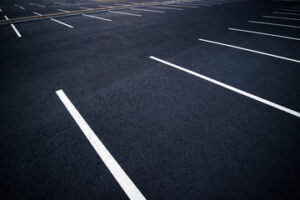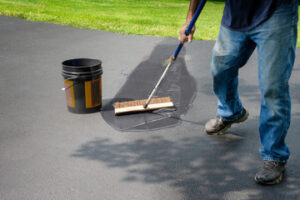Sealcoating can restore a faded asphalt parking lot or driveway to its original deep black appearance. It also acts as a protective barrier against UV rays, water, oil and other oxidizing substances.
However, the weather conditions need to be just right for this process to be successful. The temperature must be comfortable and the humidity low. Visit https://www.rochesternysealcoating.com/ to learn more.

One of the biggest reasons why asphalt driveways and parking lots need to be seal coated is that it helps protect them from damage. If asphalt is left untreated, it will eventually start to crumble, crack, and develop potholes that require costly repairs to fix. A good quality seal coat will help prevent this from happening and give your asphalt a nice, smooth, new-looking appearance for years to come.
A professional sealcoating company will examine your pavement surface to see how much damage has occurred over the years, as well as determine if there are any holes or cracks that need to be filled. They will also look for oil spots and any other areas that may need special attention such as patching and prepping. Once the area is prepared, the professionals will then spray on the sealcoat. Workers will use a specialized machine that is designed to apply a thick layer over the entire surface, including the edges. After this, workers will hand squeegee and brush the entire area to ensure it is evenly spread and to fill in any cracks or gaps.
The process of oxidation causes asphalt to become brittle, and once this happens it becomes easier for water to penetrate the surface and weaken it. It is also harder for the asphalt to resist pressure from vehicles and foot traffic, which is why it’s important to get a sealcoat every couple of years.
Getting a sealcoat will prevent the deterioration of your asphalt, and it’s an inexpensive way to maintain it for a long time. A good quality asphalt sealcoat will prevent stains, slow down the oxidation process, and fill in any cracks or holes that might occur.
It’s not just the weather that can damage your asphalt, gasoline, motor oil, antifreeze, de-icing chemicals, and salts can all stain, corrode, and destroy it as well. Sealcoating will help prevent these liquids from leaking into the asphalt and damaging it. A sealcoat will help protect the underlying structure of your asphalt, and it will also give it that brand-new black look instead of a dull gray.
It Prevents Stains
Asphalt stains are not only unsightly, they can also cause serious damage. A good sealcoat will protect the surface from oil, grease, gasoline and other chemicals. If these substances are allowed to penetrate the pavement, they can cause the deterioration of the aggregates that hold up the pavement. This in turn can lead to cracking, sink holes and severe deterioration of the whole surface. A sealcoat will stop these stains from ever occurring, and it will also prevent them from spreading.
A driveway or parking lot that is full of cracks, deterioration and discoloration can make your property look less appealing and may even deter customers. In addition, a poorly maintained parking lot can lead to safety issues and lawsuits. A proper sealcoating job can keep these problems from occurring, and it will also prolong the life of the pavement, saving you time, money and stress in the long run.
When asphalt is new, it has a deep black appearance that looks rich and inviting. As it ages, the sun and other weather conditions can fade the pavement to a dull gray or white color. A seal coat can restore the original black color of the asphalt, making your property look more attractive and increasing its value.
Another benefit of a proper seal coating is that it will slow the oxidation of the pavement. Oxidation is caused by the continuous exposure of asphalt to UV rays. As the oxidation progresses, the asphalt binder breaks down and the pavement becomes brittle. A sealcoat will prevent this oxidation from happening, keeping your pavement strong and durable.
It is important to note that a sealcoat will only work if the surface of the asphalt is free from any major damage, like cracks or potholes. These repairs should be completed before the sealant is applied. It is recommended that you hire a professional to perform these repairs, such as an experienced asphalt contractor. The right equipment, including a hot pour crack filler and a broom, can help to ensure that the asphalt is properly prepped before the sealant is applied. A broom will remove any dirt, dust, gravel or other debris that could interfere with the adhesion of the sealant.
It Increases Curb Appeal
A well-maintained asphalt parking lot isn’t just a plus for residents and visitors; it also boosts property value. A driveway or parking lot that hasn’t been sealcoated can look drab and dated, while one that has been recently sealed appears shiny and brand new. Whether you’re looking to sell your home or trying to attract tenants to your business, a jet black finish exudes an image of a well-maintained property and increases curb appeal.
Maintaining a driveway or parking lot can be expensive, especially if it’s not regularly sealcoated. Sealcoating every 2-3 years ensures that your asphalt will last longer and improves its appearance. Sealcoating is a cost-effective way to make your driveway or parking lot appear new again and adds significant value to your property.
The dark color of the sealant complements most any driveway or parking lot and makes it easier to spot oil spills and other debris before they become permanent stains. It can also help deflect heat from the sun, which can cause your asphalt to deteriorate faster.
Sealcoating also protects the pavement from harsh weather conditions like freezes, thaws, and UV rays. When applied properly, asphalt sealer acts like a waterproofing agent, reducing the rate at which water permeates through the pavement. This prevents weed growth, cracking, and surface damage.
It also helps ice and snow melt more quickly, which is important for both residential and commercial properties. This can also reduce the need for road salts, which can be very hard on blacktop. When ice and snow melt more quickly, the weight of the ice and snow is lessened, which can help avoid cracks and divots.
During the asphalt sealcoating process, workers should wear protective equipment including hard hats, long sleeves and pants, impervious gloves, and safety glasses. This is because the sealant is sticky and creates fumes during the drying process that could pose health hazards for those who are not properly protected. Proper training should be provided to workers as well to ensure they know how to work safely with coal tar emulsions, as it is a hazardous material.
It Prevents Water Damage
Asphalt pavement is a combination of rock and stone aggregates that are held together by bitumen (a petroleum-based substance). The sun’s UV rays and chemicals from car fluids can degrade the binder, leaving the surface exposed to further degradation. A sealcoat keeps this from happening by acting as a protective layer that re-establishes the bond between the aggregates. This prevents the pavement from deteriorating and forming brittle cracks that can cause severe damage to your property’s driveway or parking lot.
Another important benefit of a sealcoat is that it acts as a barrier against water. When left untreated, asphalt can easily absorb water, which can expand in cold temperatures and further break down the structure of the pavement. This can cause the cracks to grow and spread across the entire surface, making it unsafe for driving or parking. A sealcoat creates a water-resistant surface that stops water from seeping into the pavement, which can prevent further damage and keep the surface looking newer longer.
Leaking fluids are also a big problem for asphalt surfaces, as they can further break down the surface and cause more extensive damage. Oil, gasoline, antifreeze and de-icing chemicals all contain chemical compounds that can stain or corrode asphalt pavement. By preventing these liquids from seeping into the pavement, sealcoating protects the asphalt from further damage and helps it last longer.
Sealcoating is a relatively inexpensive maintenance procedure, especially when compared to the cost of full replacement or repair. The longevity of your parking lot or driveway will be significantly increased with a proper sealcoat, which can be applied every 2-4 years. In addition, a professional contractor will be able to spot minor problems and repairs before they grow into more serious issues.
Whether you are the owner of a commercial business or simply want to keep your home’s driveway looking newer and better, it is recommended that you get a sealcoat for your asphalt. It will save you time, money and hassle in the long run by protecting the structure of your asphalt and keeping it in good condition.
